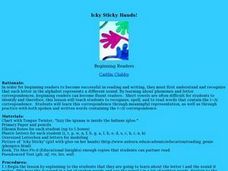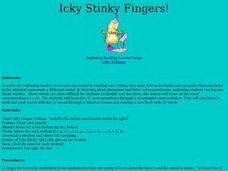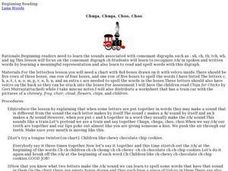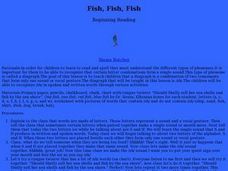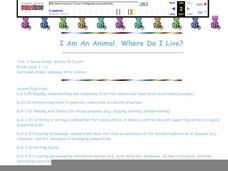Curated OER
Icky Sticky Hands!
Students examine the letter 'i'. Through instruction and modeling they explore the sound the letter makes, how the letter is written, words that contain the letter, etc. They use letterboxes to write 'i' words and read stories containing...
Curated OER
Champions Check
First graders identify consonant digraphs in written and spoken language. After a brief discussion of the combinations of /c/ and /h/ that comprise the /ch/ digraph, 1st graders practice identifying initial and final placement of the...
Curated OER
Icky Stinky Fingers!
Students examine the letter 'i'. Through instruction and modeling they explore the sound the letter makes, how the letter is written, words that contain the letter, etc. They use letterboxes to write 'i' words and read stories...
Curated OER
Chuga Chuga Choo Choo
First graders identify the digraph /ch/ in written and spoken language. After a brief discussion of the independent and combined sounds of the phonemes /c/ and /h/ students practice identifying initial and final placement of the new...
Curated OER
Abra-kadabra-kazam /a//a//a/, POOF!
First graders discover that each letter of the alphabet has a sound then detect the /a/ sound represented by the letter a. They pretend to be magicians and say, "Abra-kadabra-kazam! POOF!" emphasizing the /a/ sound and then repeat an /a/...
Curated OER
Iiizzy is Iiicky Sticky!
Students answer a series of questions about the different sounds that the letter I makes. They observe a picture about a girl and the letter I. They practice a tongue twister with the different sounds of I. They practice writing the...
Curated OER
Try Your Hand at Han'geul
High schoolers explore Han'geul, a Korean writing system. Pupils participate in a class discussion involving the history of Han'geul. Using specified websites, classmates create flashcards containing letters of the Han'guel language. ...
Curated OER
Everyone is Reading
Students study /e/ in both written and spoken words using a tongue twister and letterbox activities. They recite a tongue twisters and make words using letterboxes. Next, they read "Red Gets Fed" and find words that contain the /e/...
Curated OER
Fish, Fish, Fish
Pupils identify the digraph /sh/ in written and spoken language. After a brief discussion the independent and combined sounds of the phonemes /s/ and /h/ students practice identifying initial and final placement of the new digraph /sh/...
Curated OER
Ellen the Elephant
Pupils build their sight vocabulary. They study the short vowel correspondence e. They practice pronouncing the /e/ phoneme when shown the grapheme e in written words. They read e = /e/ and write words that contain the e correspondence.
Curated OER
Bob and the Frogs Hop on Logs
Students complete a variety of activities as they explore/review the letter 'o' as it makes the /o/ sound. They recite tongue twisters and practice writing words with the /o/ sound. They read a story and choose /o/ words from the story...
Curated OER
Your Future Occupation
Students write a story about themselves as the main character in a work situation. In this writing perspectives lesson, students brainstorm about their future occupation. Students then use themselves as the main character in a short...
Curated OER
Grandpa Ed
Students engage in an emergent literacy lesson that focuses on phonemic awareness. For practice they become more comfortable with a short vowel phoneme, which can often be the most difficult to identify, by learning it in isolation.
Curated OER
B is for Bowling Green
Third graders identify important places in Bowling Green and list facts about those places. They write complete, varied sentences using capitals and punctuation correctly and also use the Writing Process. As a final project, a...
Curated OER
Touring My County
Second graders research important events that occurred in their counties for each year they have been alive. They, in groups, categorize these events and develop notes to be used in the writing of an autobiography.
Curated OER
I Am An Animal: Where Do I Live?
Students make an alphabet booklet using the computer to find pictures and facts about farm animals, zoo animals and pets. They write facts about the animals: where they live, what they eat, their coloring, etc.
Curated OER
My Own Picture Dictionary
Students create a picture dictionary that includes images of people and things that are important in their lives. They identify pictures of people and things that are important in their lives.
Curated OER
Hidie Ho H!
Students become more familiar with the letter and sound of h by using the poem, Humpty Dumpty. They are given a sequencing sheet, a pair of scissors, crayons, and a piece of construction paper and told to put pictures in the correct order.
Curated OER
Lines & Spaces; Another Round
Fourth graders recall the letter names of the notes of the C-major scale and identify the names of the C-major scale. They identify the names of the lines and spaces on a music staff. They sing rounds.
Curated OER
Alphabetizing Words Beginning with L and M
Students practice ordering words. In this alphabetizing lesson, students develop their alphabet skills by putting words starting with L and M in alphabetical order.
Curated OER
More for Images and Lists
Students design a hyper-linked graphic without a bounding border. They examine how to place a framing border around an inline image. They apply HTML to list using a number styles.
Curated OER
How Many Feet Will We Meet?
Emerging speakers distinguish between the sounds for short vowel /e/ and long vowel /e/. They are introduced to the vowel patterns that comprise the long vowel sounds, with emphasis on /ee/. They practice reading and spelling a variety...
Curated OER
Short 'A' and Phoneme Blending
Have your class explore the short /a/ sound. They will pronounce isolated consonant and short /a/ sounds and then blend the sounds to make a word. An assessment sheet is provided.
Curated OER
Getting To Know You
Students use personal information to enter into a teacher generated database. The focus is upon name recognition and promoting socialization with classmates. Word recognition is emphasized with the simple development of basic computer...
